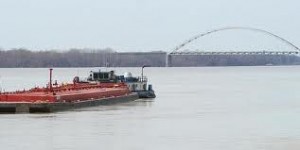Fracking Wastewater Barge Transport in Planning Phase
Excerpted Article By Emily DeMarco of PublicSource on December 16, 2012
The shale gas drilling industry wants to move its wastewater by barge on rivers and lakes across the country. But the U.S. Coast Guard, which regulates the nation’s waterways, must first decide whether it’s safe. “It may be hazardous,” said Commander Michael Roldan, chief of the Coast Guard’s Hazardous Material Division, stressing the word ‘may.’ “If it is, it would not be allowed to ship under bulk.”
Right now, he pointed out during an interview with PublicSource, it can’t be shipped by barge, even though there has been confusion in Pittsburgh, West Virginia and Ohio about whether it could be.
The Coast Guard’s decision would affect more than Pittsburgh’s iconic three rivers. Nearly 12,000 miles of waterways could be open to these waterborne behemoths, each carrying 10,000 barrels of wastewater.
Environmentalists said the possibility of a spill that could contaminate Pittsburgh’s rivers with chemicals isn’t worth the risk. But industry officials who advocate waterway transport said barges are the safest, and cheapest, way to move this stuff. A barge accident would be a “massive catastrophe,” said Steve Hvozdovich, Marcellus campaign coordinator for Clean Water Action, a national environmental advocacy organization. “It’s not just a contamination of a waterway,” Hvozdovich said. “You’re talking about the contamination of the drinking water supply for about half a million people….It seems like a very bad idea.”
However, industry officials and transportation experts counter that other industrial materials, some toxic, are moved on barges now. They include chlorine, hydrochloric acid and anhydrous ammonia. Why should the drilling industry be treated differently? they ask.
Anyone who says moving the wastewater is a danger doesn’t know what’s on the waters already, said John Jack, vice president of business development and operations for GreenHunter Water, a company that handles wastewater for major oil companies.
Complications arise for the Coast Guard’s analysis because companies use proprietary mixtures of chemicals in fracking. And, salt, hydrocarbons and radioactive elements that occur naturally underground catch a free ride with the watery mixture to the surface. “If there wasn’t the variability, this would be a much easier process,” Roldan said.
Ring-around-the-tub effect
The Coast Guard’s biggest concern about the wastewater is what Roldan calls the ‘bathtub ring’ effect inside the barges. Just as, after many showers and baths, calcium in tap water can leave a ring around the tub, radioactive particles in the wastewater may accumulate inside the barge. Workers and inspectors on the barges could be at risk after long-term exposure, he said, and the agency would likely require regular testing of the barges for radioactivity.
Less road wear and tear
Shale gas companies have good reason to eye the waterways.Transporting wastewater by barges has environmental, safety and economic benefits, Jack, of GreenHunter, said. For example, a major drilling company would save 58,000 trucking hours by using barges. And trucks have about 2,000 accidents for every barge accident, he said, citing data from the DOT and the Coast Guard.
And they’re a fraction of the cost. Barges cost only about 10 percent of the cost to move the waste by truck, said Jim Kruse, director of the Center for Ports and Waterways Institute at Texas A&M University. They are 20 to 30 percent cheaper than trains, he said.
Benjamin Stout, a biology professor at Wheeling Jesuit University about 60 miles southwest of Pittsburgh, is one expert who didn’t know about the Coast Guard’s review. “Oh crap,” he said. “A lot of things could go wrong.” For example, wastewater contains bromides. Bromides transform into carcinogens when they are pumped through water treatment facilities, Stout said. If there was a barge accident, the treatment facilities would have to shut their intake valves of river water, he said. Cities such as Pittsburgh and Wheeling use water from the Ohio River for drinking.
(Stout is a board member of FracTracker, a non-profit that disseminates data about the shale gas industry. Both FracTracker and PublicSource are funded, in part, by the Heinz Endowments.)


{ 2 comments… read them below or add one }
I think transporting the stuff in barges makes sense. I worked on the river for 11 years and we shipped a lot of liquid cargos everywhere. Never had one sink or leak.
My question is: Where are they taking it? That’s not explored in this article. I believe it would be safe to ship via barge, but I would want to know the destination, too.
Capt. Tim of the Monongahela Monitor
Monongahela River Revival
Tim, that’s a really great question, and one that we have been hearing a lot. We would encourage you or anyone with information on that topic to contact PublicSource reporter Emily Demarco (412.315.0262, edemarco@publicsource.org).
Thanks so much for your comments and keep an eye on publicsource.org for more coverage about important topics in the PA/WV region!
PublicSource: http://www.publicsource.org